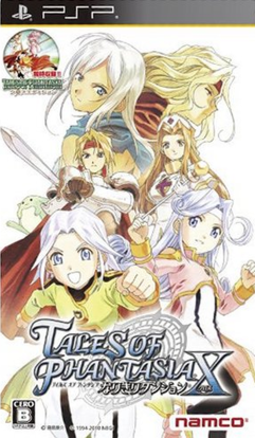
Towards the end of the turn of the millennium, Namco released a spinoff title of the Tales series entitled Tales of Phantasia: Narikiri Dungeon, with the word “narikiri” not having a clear English equivalent, loosely translating as “the act of becoming something else completely,” which somewhat references the gameplay, as this reviewer would mention. The spinoff game for the GameBoy Color would remain in Japan, as would an enhanced remake that would see its release about a decade later, Tales of Phantasia: Narikiri Dungeon X (pronounced “cross”), which included a nice addition: the fifth remake of Tales of Phantasia, subtitled Cross Edition (for more information on that game, readers can read this writer’s review). Narikiri Dungeon X itself is a solid remake of the game, in spite of rehashing some material from its prequel.
Whereas the original version used a simple turn-based version of the Tales battle system, its remake updates the system to be on par with that found in other Tales titles, with randomly-encountered battles breaking up dungeon exploration. The main characters are siblings Dio and Mel, along with the game’s mascot, Kruelle, whose utterances mostly consist of its own name. Players can, however, mix up their party as they please, although they’re still limited to four members, some of which can include the heroes of the first Phantasia game. For Dio and Mel, the game sports a kind of class system where they can change into various costumes that affect their equipment and abilities, with each class having three different masterable levels.
As with most other contemporary Tales titles, players can chain combos against enemies to increase damage dealt. MP doesn’t exist in the remake, with each character instead having a meter whose points increase with damage dealt to enemies, some of which depletes whenever a character executes a special skill. Battles typical contain a fast pace, along with adjustable difficulty perfect to accommodate those who don’t like a challenge and masochists. Winning nets experience points for occasional levels up, points towards costume mastery, and money for purchasing new equipment and items. Overall, the battle system is one of the primary draws to the game, with some fights posing a challenge even on the easiest difficulty, though mercifully, players can make liberal use of items in battle, and the only real flaw is the inability to use healing magic outside battle.
The game’s controls are generally above average, with easy menus, shopping, and whatnot, not to mention a simplified world exploration system where the player chooses locations from a map instead of wandering across the map themselves like in Phantasia, accounting for a more linear structure than in most other games in the franchise. Unless the player is somehow fluent in Japanese, however, it can nonetheless be difficult to know where to go next to advance the plot, or which period to go to, no less, and a few puzzles, particularly towards the end of the game, demand a decent knowledge of Nipponese. In a surprise, however, dungeons actually have maps that mostly prevent players from losing themselves. Ultimately, interaction is generally solid.
The story is probably X’s weakest link, what with an emphasis on time travel like in the first Tales of Phantasia and some occasional hidden history for Dio and Mel, but otherwise, the direct sequel doesn’t contribute much new to the Phantasia timeline.
Motoi Sakuraba’s soundtrack, as usual, is catchy in spite of some rehashed themes from Phantasia, with the Japanese voicework generally being decent aside from the typical Nipponese mispronunciation of English words.
X uses a visual style combining three-dimensional scenery, which actually looks pretty good, with two-dimensional character sprites whose pixilation isn’t too bad, accounting for a beautiful game.
Finally, the game is fairly short, taking from ten to fifteen hours to finish, although players can purchase bonuses from the Grade store and start a New Game+ upon beating the title. In the end, Tales of Phantasia: Narikiri Dungeon X, for the most part, accomplishes a good job as both a remake and a direct sequel, what in particular with its solid Tales gameplay, sound, and visuals, although there are some minor flaws that the developers could have improved, such as enhancing the game’s import-friendliness not to mention the plot, although since Tales titles tend to lack in aspects such as the plot, these shortcomings, to the average Tales fanatic, are most certainly forgivable.
The Good:
+Includes fifth remake of the original Tales of Phantasia.
+Solid Tales gameplay.
+Great sound.
+Nice visuals.
+Excellent replay value.
The Bad:
-Story is generic.
-Some recycled music.
The Bottom Line:
Another fun Tales game, and Phantasia X is a nice bonus.
Score Breakdown:
Platform: PlayStation Portable
Game Mechanics: 9/10
Controls: 8/10
Story: 7/10
Music/Sound: 8/10
Graphics: 9/10
Lasting Appeal: 10/10
Difficulty: Adjustable
Playing Time: 10-15 Hours
Overall: 8.5/10









